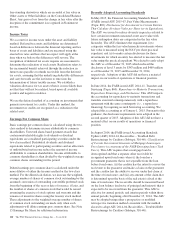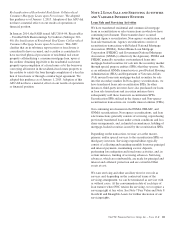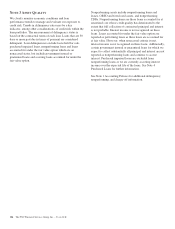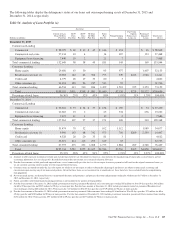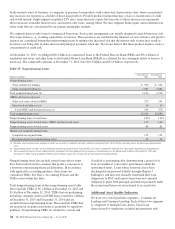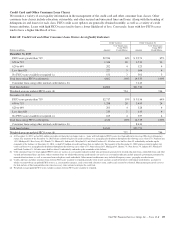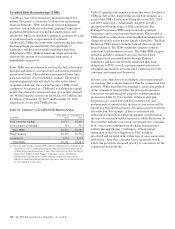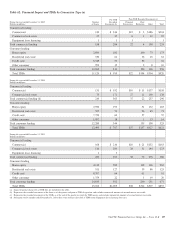PNC Bank 2015 Annual Report Download - page 148
Download and view the complete annual report
Please find page 148 of the 2015 PNC Bank annual report below. You can navigate through the pages in the report by either clicking on the pages listed below, or by using the keyword search tool below to find specific information within the annual report.
Table 56: Commercial Lending Asset Quality Indicators (a)(b)
Criticized Commercial Loans
In millions Pass Rated
Special
Mention (c) Substandard (d) Doubtful (e) Total Loans
December 31, 2015
Commercial $ 93,364 $2,029 $3,089 $ 90 $ 98,572
Commercial real estate 26,729 120 481 5 27,335
Equipment lease financing 7,230 87 150 1 7,468
Purchased impaired loans 6 157 6 169
Total commercial lending $127,323 $2,242 $3,877 $102 $133,544
December 31, 2014
Commercial $ 92,884 $1,984 $2,424 $ 55 $ 97,347
Commercial real estate 22,066 285 639 35 23,025
Equipment lease financing 7,518 73 93 2 7,686
Purchased impaired loans 4 280 26 310
Total commercial lending $122,468 $2,346 $3,436 $118 $128,368
(a) Based upon PDs and LGDs. We apply a split rating classification to certain loans meeting threshold criteria. By assigning a split classification, a loan’s exposure amount may be split
into more than one classification category in the above table.
(b) Loans are included above based on the Regulatory Classification definitions of “Pass”, “Special Mention”, “Substandard” and “Doubtful”.
(c) Special Mention rated loans have a potential weakness that deserves management’s close attention. If left uncorrected, these potential weaknesses may result in deterioration of
repayment prospects at some future date. These loans do not expose us to sufficient risk to warrant a more adverse classification at this time.
(d) Substandard rated loans have a well-defined weakness or weaknesses that jeopardize the collection or liquidation of debt. They are characterized by the distinct possibility that we will
sustain some loss if the deficiencies are not corrected.
(e) Doubtful rated loans possess all the inherent weaknesses of a Substandard loan with the additional characteristics that the weakness makes collection or liquidation in full improbable
due to existing facts, conditions, and values.
Consumer Lending Asset Classes
Home Equity and Residential Real Estate Loan Classes
We use several credit quality indicators, including
delinquency information, nonperforming loan information,
updated credit scores, originated and updated LTV ratios, and
geography, to monitor and manage credit risk within the home
equity and residential real estate loan classes. We evaluate
mortgage loan performance by source originators and loan
servicers. A summary of asset quality indicators follows:
Delinquency/Delinquency Rates: We monitor trending of
delinquency/delinquency rates for home equity and residential
real estate loans. See the Asset Quality section of this Note 3
for additional information.
Nonperforming Loans: We monitor trending of
nonperforming loans for home equity and residential real
estate loans. See the Asset Quality section of this Note 3 for
additional information.
Credit Scores: We use a national third-party provider to
update FICO credit scores for home equity loans and lines of
credit and residential real estate loans at least quarterly. The
updated scores are incorporated into a series of credit
management reports, which are utilized to monitor the risk in
the loan classes.
LTV (inclusive of combined loan-to-value (CLTV) for first
and subordinate lien positions): At least annually, we update
the property values of real estate collateral and calculate an
updated LTV ratio. For open-end credit lines secured by real
estate in regions experiencing significant declines in property
values, more frequent valuations may occur. We examine
LTV migration and stratify LTV into categories to monitor the
risk in the loan classes.
Historically, we used, and we continue to use, a combination
of original LTV and updated LTV for internal risk
management and reporting purposes (e.g., line management,
loss mitigation strategies). In addition to the fact that
estimated property values by their nature are estimates, given
certain data limitations it is important to note that updated
LTVs may be based upon management’s assumptions (e.g.,if
an updated LTV is not provided by the third-party service
provider, home price index (HPI) changes will be incorporated
in arriving at management’s estimate of updated LTV).
Geography: Geographic concentrations are monitored to
evaluate and manage exposures. Loan purchase programs are
sensitive to, and focused within, certain regions to manage
geographic exposures and associated risks.
A combination of updated FICO scores, originated and
updated LTV ratios and geographic location assigned to home
equity loans and lines of credit and residential real estate loans
is used to monitor the risk in the loan classes. Loans with
higher FICO scores and lower LTVs tend to have a lower
level of risk. Conversely, loans with lower FICO scores,
higher LTVs, and in certain geographic locations tend to have
a higher level of risk.
130 The PNC Financial Services Group, Inc. – Form 10-K


